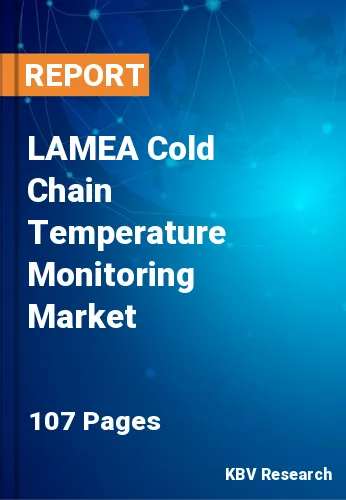The Latin America, Middle East and Africa Cold Chain Temperature Monitoring Market would witness market growth of 24.3% CAGR during the forecast period (2020-2026). The need for better productivity in the temperature-controlled supply chain has had a positive effect on the demand for monitoring the cold chain. In addition, growing demand for refrigeration in sectors such as food and beverage (F&B) and healthcare has increased the importance of monitoring the cold chain. F&B continues to be the main area of application for cold chain management solutions, as frozen or cooled product segments tend to experience unwavering growth around the globe. Chemicals and pharmaceuticals are the other two domains that demand unfailing regulated room temperature solutions and are expected to play a significant role in stimulating the development of the market for controlling the cold chain in the near future. In addition, considerations such as the mushrooming of refrigerated warehouses worldwide and regulatory mechanisms have propelled the popularity of cold chain monitoring.
The driving factor for solutions for monitoring the cold chain is the increase in the demand for frozen food, the efficiency of the supply chain for processed dairy products and others. Strengthening requirements pertaining to the storage and shipment of pharmaceuticals are anticipated to stimulate demand for these monitoring solutions. In addition, increased private and government investments in the development of refrigerated warehouses and government efforts to eliminate corruption in food and other temperature-sensitive products are expected to boost the global demand for monitoring the cold chain during the forecast period.
The growth of the market for monitoring the cold chain is expected to lead, particularly as demand for pharmaceuticals in developing countries is growing. Some pharmaceuticals are very temperature sensitive and require successful temperature control techniques to preserve the desired temperature in the supply chain. Product damage during shipping may be prevented by the use of a cold storage control system to place products at the required temperature.
Based on Component, the market is segmented into Hardware and Software. Hardware market is further segmented into Conventional Temperature Loggers, Real-Time Monitoring Devices, Temperature Indicators, Resistance Temperature Detectors and Others. Software segment is further categorized into On-premise and Cloud. Based on End User, the market is segmented into Fish, Meat & Seafood, Processed Food, Pharmaceuticals, Bakery & Confectionaries, Fruits & Vegetables, Dairy Products and Others. Based on countries, the market is segmented into Brazil, Argentina, UAE, Saudi Arabia, South Africa, Nigeria, and Rest of LAMEA.
Free Valuable Insights: Cold Chain Temperature Monitoring Market in LAMEA is expected to register a CAGR of 24.3% during the forecast period (2020-2026)
The market research report covers the analysis of key stake holders of the market. Key companies profiled in the report include Daikin Industries, Ltd., Zest Labs, Inc. (Ecoark Holdings, Inc.), Orbcomm, Inc. (Northrop Grumman Corporation), Carrier Global Corporation (Sensitech, Inc.), Berlinger & Co. AG, Monnit Corporation, Infratab, Inc., Klinge Corporation, Savi Technology, Inc., and Veridify Security, Inc.
Market Segmentation:
By Component
By End-User
By Country
Companies Profiled
Our team of dedicated experts can provide you with attractive expansion opportunities for your business.

